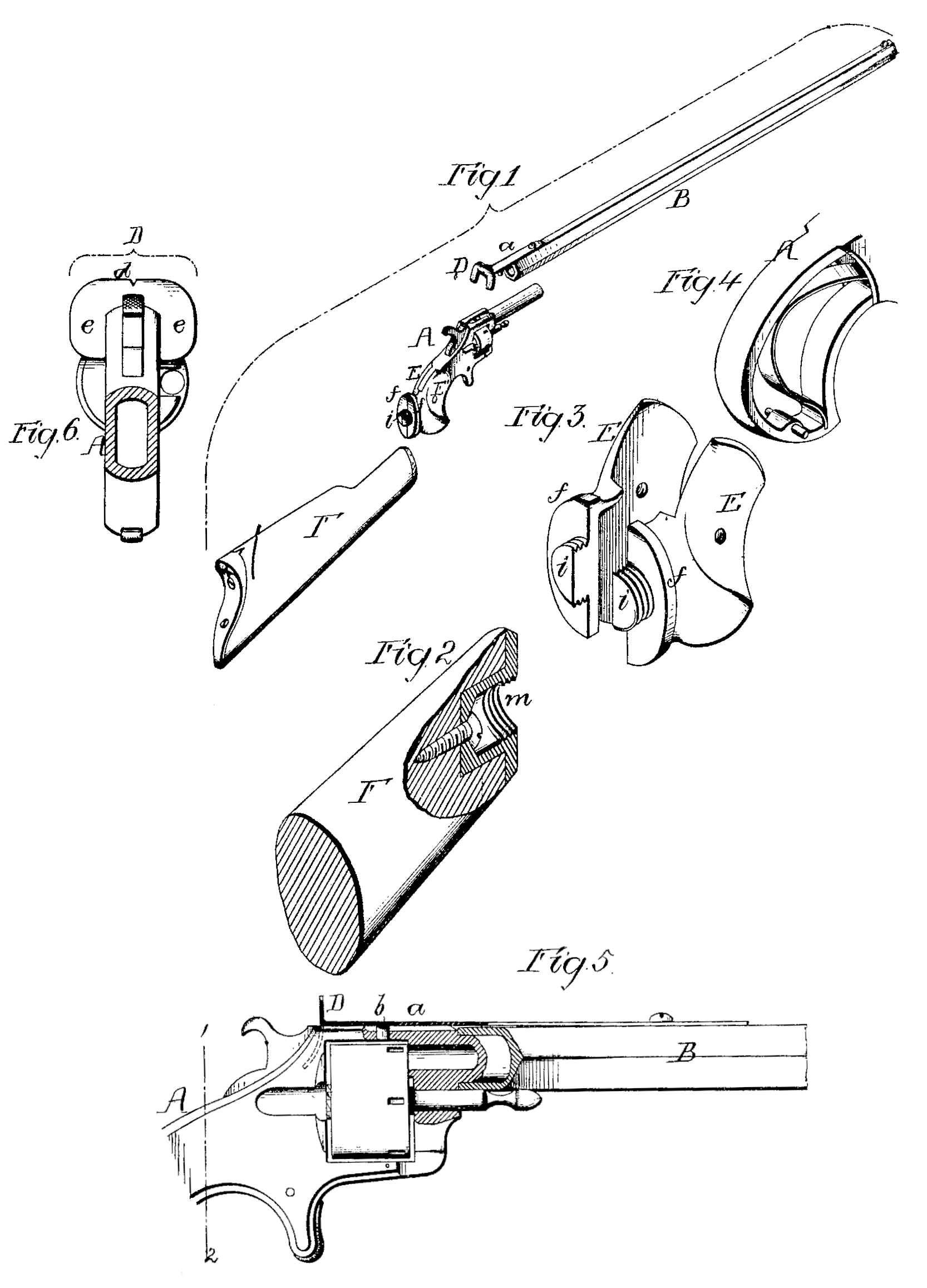US 194489
UNITED STATES PATENT OFFICE.
THOMAS M. WALLIS, OF PHILADELPHIA, PEN NSYLVANIA, ASSIGNOR OF ONE-HALF HIS RIGHT TO WILLIAM WURFFLEIN, OF SAME PLACE.
IMPROVEMENT IN REVOLVING FIRE-ARMS.
Specification forming part of Letters Patent No. 194,489, dated August 21, 1877; application filed
To all whom it may concern:
Be it known that I, Thomas M. Wallis, of Philadelphia, Pennsylvania, have invented a new and useful Improvement in Revolving Fire-Arms, of which the following is a specification:
The main object of my invention is to so construct a revolving rifle or other fire-arm as to prevent the rearward projection of ignited or other particles into the face of the person firing the weapon, a further object being to construct the rifle in sections, which may be readily put together or taken apart, and, when taken apart, will occupy but little space.
These objects I attain in the manner which I will now proceed to describe, reference being had to the accompanying drawing, in which—
Figure 1 is a perspective view of my improved revolving rifle, the sections of which it is composed being separated from each other; Figs. 2, 3, and 4, detached perspective views, showing, respectively, a portion of the stock, the side plates of the handle, and a portion of the frame, illustrating the mode of connecting the stock to the body of the weapon; Fig. 5, a side view, partly in section, of a portion of the rifle; and Fig. 6, a transverse section on the line 12, Fig. 5.
A represents a revolver of the ordinary construction, except in the matter of the side-plates of the handle, which will be referred to hereinafter.
B is a barrel, of any suitable length, the rear end of this barrel fitting snugly over the barrel of the revolver, and being provided with a spring-plate, a, carrying a pin, b, adapted to an opening in the frame of the revolver, as shown in Fig. 5.
In the present instance the rear end of this spring-plate is bent and enlarged, so as to form a guard, D, which has a portion, d, extending over the top of the frame, and two wings or ears, e e, at each side of the same. These wings or ears e e are immediately in the rear of and extend some distance beyond the circumference of the cylinder of the revolver, as shown in Fig. 6.
In revolving fire-arms there is always more or less leakage of gases, &c., at the joint between the front edge of the cylinder and the rear end of the barrel, and small particles of powder or other substances escaping here strike the front portion of the frame and are projected rearward with sufficient force to strike the face of the person firing the weapon, if the latter is held close to the face.
It will be evident that the use of the guard D will effectually prevent this rearward projecting of small particles, while at the same time it does not interfere with the proper holding and sighting of the weapon.
The side plates E E of the handle are provided at the rear end with projections f f, which together embrace the rear edge of the frame, and each of these projections f has a semicircular lug, i, on which is formed a screw thread, the two lugs when the plates are in position, as in Fig, 1 forming a threaded cylindrical projection, adapted to a threaded opening, m, in a metal plate secured to the front edge of the wooden stock F of the weapon. (See Fig. 2.)
The barrel B and stock F can be easily applied to or removed from the revolver, and when applied produce a light and easily-handled revolving rifle, which will shoot with accuracy at comparatively long ranges.
The use of the projections f and lugs i on the side plates of the handle does not interfere with the ordinary use of the revolver, when the barrel and stock are removed from the same.
Neither is it necessary that the lugs i of the projections f should be threaded, as shown, as the means of connection between the revolver and stock may be a bayonet-joint or other substitute for the screw, in which case the character of the lugs would be modified to accord with the change in the mode of fastening.
The barrel and stock may be applied to a single-barreled pistol, if desired, but the use of a revolver is to be preferred.
I claim as my invention—
1. The combination of the frame and barrel of the weapon A with the barrel B and its spring-pin b, as specified.
2. The combination of the revolver A with the barrel B, provided with a plate, a, and guard D, as specified.
3. The combination of the frame of the weapon. A with the handle-plates E, having projections f, with lugs i for attachment to the stock, all substantially as set forth.
4. The combination of the stock F and its threaded socket on with the weapon A and its handle-plates E, having projections f with threaded lugs i, as specified.
In testimony whereof I have signed my name to this specification in the presence of two subscribing witnesses.
T. M. WALLIS.
Witnesses:
Harry A. Crawford,
Harry Smith.

